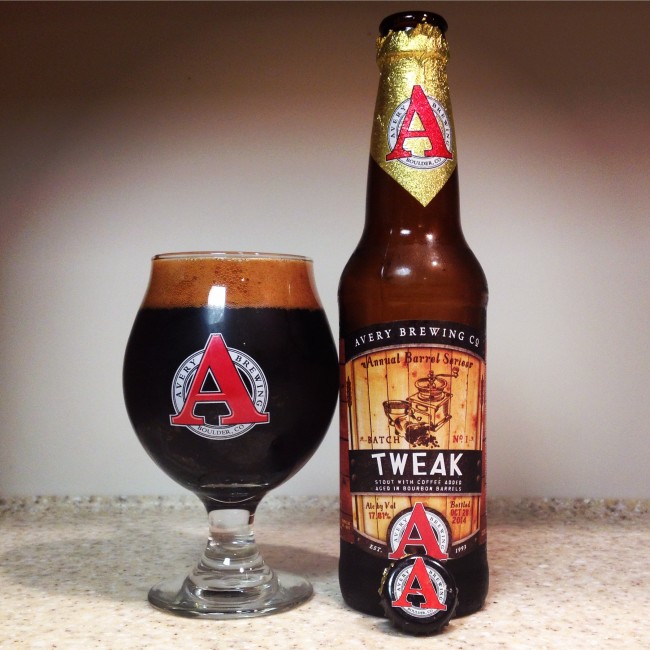With the cruel, skeletal fingers of winter threading their way into your everyday life, it’s the little, warm things that tend to alleviate the unpleasantness of the frigid weather: hot cocoa, chicken soup, fuzzy blankets, and fermented beverages among them (although some alcoholic beverages tend to be warm in the “burns going down” sense).
With the cruel, skeletal fingers of winter threading their way into your everyday life, it’s the little, warm things that tend to alleviate the unpleasantness of the frigid weather: hot cocoa, chicken soup, fuzzy blankets, and fermented beverages among them (although some alcoholic beverages tend to be warm in the “burns going down” sense). While the high alcohol content associated with that sensation is why most consume stronger alcoholic drinks, big-time flavor is also a consideration for many. Cheap vodka is likely not purchased for its stunning aromatics and depth of flavor, but high-alcohol beers are.
High alcohol content in beer can be the result of a couple of things: massive amounts of grain, and therefore sugar, are why many beers in various stylistic categories inch towards the double digits in terms of alcohol content. Barrel-aging, particularly the kind done with spent spirit barrels, also adds not only flavor and aroma, but a slight spike in alcohol content. Also employed to create beers high in alcohol is the technique of freeze distillation, used in Eisbock beers like Strangeways’ Freeze Ray, in which brewers partially freeze a brewed product, scrape off excess ice, and are left with a richer, more concentrated beer. Beers made with that process are usually in the 10 to 12 percent range, although the technique has been taken to further extremes by breweries such as BrewDog, with beers such as Sink The Bismarck!, a 41 percent imperial IPA.
While beers like Sink The Bismarck! are intriguing from a technical standpoint, and are interesting to sample as a sort of novelty, there are plenty of people out there that scoff at beer like that, and even decry the barrel-aged Imperial Stouts that have become extremely popular amongst beer drinkers within the last few years. From a purist’s standpoint, the “extreme” beers of the craft beer movement are non-traditional in a bad way: American Double IPAs and the like are sometimes viewed as unbalanced and excessive, in contrast to perhaps an English Mild, straight from the cask. The temperatures sometimes required to attain high levels of ethanol tend to be too high for yeast to survive, and flavors that may be seen as traditionally “off,” or at least too overt, can surface as a result. Also, the use of ingredients aside from water, hops, malt, and yeast, such as coffee and chocolate, are not traditional, and as such, could be seen as overshadowing a base beer.
While the purists’ standpoint is understandable, there is plenty of room for experimentation and tinkering in the beer realm if one is to be mindful and respectful of tradition, while maintaining a forward course. Many of the breweries that are part of this list also make wonderful examples of more mild styles like Brown Ales and Belgian Witbiers, with the same attention to detail and love for the craft that they apply to massive, hop-and-malt-forward American Barleywines. That said, the intention of this article is to highlight some of the biggest and best beers currently made, although they are all limited in availability.

Dark Horse Brewing Co. (Marshall, MI) – Plead The 5th Imperial Stout (Russian Imperial Stout)
Starting this list off is a very special beer, in that it was only available to drink, in my apartment, for about an hour. That’s only partially a joke — this profile of Plead The 5th is based on a bottle of the beer that I had aged for a year. At 11 percent alcohol by volume, this beer is an excellent candidate for aging. Dark Horse also doesn’t filter their beers, another reason why I felt okay with putting the bottle in a room-temperature, lightproof box for a year. The high alcohol content means that the organic compounds that make up the flavor and aroma of the beer were able to be preserved better than if the beer’s alcohol content were closer to that of a pilsner, around five percent. The fact that the beer wasn’t filtered means that residual yeast, assuming there were still some living after brewing, heavily influenced the flavors developed in the aging process. Yeast in an unfiltered or bottle-conditioned beer simply do what yeast do best in terms of beer: generate flavor. Letting those little microorganisms swim around in a sealed container of beer means that they let their yeast flag fly, generating all sorts of unique, fruity flavors and aromas caused by the chemical compounds they excrete, esters. Sometimes yeast clean up the very esters that they generate, clarifying certain flavors, and eliminating others, given enough time.
Also indicated by the ABV and the style, Russian Imperial Stout, is that a massive amount of malt was used in this beer, malt being one of the aspects of beer that tends to age best. Hops are highly volatile in terms of their durability. The essential oils in hops fade fast, and require refrigeration to be preserved. However, even after three months in a refrigerated setting, a beer that might have been a resinous hop bomb when fresh will start showing signs of age, with the underlying malt flavors starting to take over the flavor profile. The presence of any barrel-aging and/or adjunct ingredients in a beer will fall off with age as well. While Plead The 5th is an amazing beer fresh — it tastes like a beer-coffee-fudge brownie with a viscous mouthfeel to match — the massive amount of malt used has to be counterbalanced by a large amount of hops, and the alcohol content is definitely noticeable, though not unpleasant. Delicious by any beer nerd’s standards, but not necessarily accessible. Letting the beer sit for a year in proper conditions (no light, stable temperature around fifty to seventy degrees fahrenheit) lets the yeast generate flavor, and allows the hop and alcohol presences to mellow.
Aging beer is always a crapshoot. Unless there is a very specific fridge or room in your house for aging, conditions will vary slightly over the course of the time spent aging, and the development of flavors can be slightly unpredictable. As always, your own palette is also a big part of the equation; someone can tell you that a certain beer is best with a year of age on it, but to you, it may be perfect fresh. I don’t intend to make any preferential claims in regards to how to enjoy Plead The 5th, and it’s always important to keep in mind that when a beer is fresh and stored properly, that is how the brewer intended the beer to be presented. That said, this beer is magical with a year of age on it. When poured, it’s basically pitch-black, with a minimal, creamy, light brown head generated if poured aggressively. The first smell that hits the nose is a soy sauce-like savory smell, likely generated by yeast killed off in the brewing process. Following that are rich aromas of dark fruits like figs, and chocolate. The flavor is incredibly complex, but not overwhelming, replete with notes of dark-roast coffee, fig, black cherry, dark chocolate, tart raspberry, vanilla, and a bit of an ethanol in the aftertaste. The body directly compliments the flavors, as it is fairly low in carbonation, and somewhat viscous, with a little alcohol burn still present. Dark Horse releases Plead The 5th in February, as the last of a series of five stouts, one released for each month of winter, starting with the release of One Oatmeal Stout in October. Grab a few bottles, and lay one or two down for a while.

Avery Brewing (Boulder, CO) – Tweak (American Imperial Stout) & 5 Monks (Belgian Quadrupel)
Avery has a long history of producing massive beers, such as the Demons of Ale series, alongside an excellent and dependable lineup of seasonal and year-round brews. Within the past few years however, the brewers at Avery have massively stepped up the production of their barrel program, meaning more experimentation and better distribution for brews that at one time probably didn’t make it far out of Colorado. In addition to excellent annual releases like Uncle Jacob’s Stout and Rumpkin, newer, even more limited and rare beers like Tweak and 5 Monks have appeared in Virginia and elsewhere.
Although it was bottled in October of 2014, Tweak should still be able to be found around Richmond. The reason for that would probably be that it has an unusually hefty price tag for a 12-ounce bottle, as does 5 Monks (bottled in July 2014) — usually in the neighborhood of $15. This is no arbitrary price point, despite what the gold foil on the bottle may make you think. Great expense needed to be taken to brew beers of this caliber, and that has been passed on to the consumer. Tweak is essentially Avery’s Mephistopheles’ Stout, already an expensive beer to make, with coffee added, and aged in bourbon barrels for four months, bumping up the 2013 vintage of Mephistopheles’ ABV up from 15.4 percent to 17.81 percent. 5 Monks’ 19.39 percent ABV and similarly high price point is derived from the massive amount of malt, Belgian candy sugar, Turbinado sugar, and bourbon barrel aging used to produce the unprecedented “Quintupel” ale.
I can attempt to justify the price points for these beers all I want, but really, smelling and tasting these beers is the only way to truly understand how a 12-ounce bottle of liquid could be so expensive. Tweak pours a menacing blackish shade of brown, with a fast-dissipating light brown head. The aroma is intense: a practically antiseptic booziness jumps out of the glass, alongside dark chocolate, and of course, coffee. The taste is equally intense, but more complex: a mixture of dark and milk chocolate flavors meld with notes of coffee, dates, caramel, vanilla, molasses, anise and herbal liqueur, rum, and a good bit of ethanol character. The mouthfeel is comfortingly thick and luscious, with a booze burn that cuts through. While Tweak is certainly worth experiencing somewhat fresh, especially for fans of bourbon and other spirits, some age could really make it shine. Although, one would have to be careful to catch it at just the right point–after the booze dies down a bit, but not after the coffee and barrel characteristics have completely faded. Around six to nine months from bottling should yield some interesting results.
Although the brewing and aging processes used to make 5 Monks were probably similar to those used to make Tweak, there are some important differences in how the beers were made, and therefore, how the final products turned out. 5 Monks is styled after Belgian Quadrupel ales, although amped up considerably, so a Belgian yeast strain was employed, giving the beer more overt fruity esters. Two types of sugar were used, resulting in residual sugars that make the beer sweeter than it would be if it were just sweetened with the sugars produced by the malt.
The bottle claims that the beer is a “Quintupel Ale,” a term coined by Avery for this beer, also adding that the term “sextupel” seems a bit inappropriate when considering monastic tradition of the style. So this beer is essentially a quad, just with more of every ingredient used, resulting in a bigger beer. It appears just as one might imagine it would: dark brown, practically maroon, with a soapy khaki head that fades away fast. The aroma consists of dates, caramel, salty and savory notes, and some vegetal characteristics that are a bit hard to pinpoint. The flavor follows with more date, espresso, vanilla, caramel, grape and grape Brandy, wood, and some ethanol character. The mouth feel is expectedly full, sticky sweet, and hardly carbonated. Though not as intense as Tweak, this beer could develop interestingly with age, as the booze character would drop off, and the fruity aspects could develop into something really spectacular. As it is though, with around seven months of age on it, 5 Monks is enjoyable, comparable to a dessert wine, or an after-dinner glass of Cognac.

Dogfish Head Craft Brewery (Milton, DE) – Raison D’Extra (Belgian Strong Dark Ale/Belgian Brown Ale)
Dogfish Head is famous, in fact somewhat infamous, for brewing oddball historically-based beers, and outrageously strong beers like World Wide Stout, 120 Minute IPA, and Olde School Barleywine, all of which are somewhere between 15 and 18 percent alcohol by volume every time they are brewed (Dogfish doesn’t print the ABV on the labels). Raison D’Extra continues that tradition of high-gravity beers, although unlike its aforementioned boozy brethren, this beer hasn’t been made since 2007, making its recent release all the more special.
Raison D’Extra is modeled after Dogfish Head’s own Raison D’Être (hence the punniness), a Belgian-style brown ale made with beet sugar and raisins, although D’Extra is bolstered with brown sugar, even more malt, beet sugar, and raisins, basically doubling the recipe, and therefore, the eight percent ABV of D’Être. What emerges from that over-the-top brewing process is an ale with a gorgeous ruby read hue, and a minimal white head. Scents of vanilla, cherry, brown mustard, and boozy grape Brandy emerge from the glass. Flavors of coffee, roasted nuts, edamame, wine grapes, caramel, black pepper, raisins, soy sauce, and herbal liqueur are present, along with a cherry flavor that borders on tasting like cough syrup. The mouthfeel is full, sugary, highly carbonated, and leaves a tickle of booziness behind. A very enjoyable sipper, similar to drinking a grape Brandy or Cognac, this beer should age very, very well, given that online reviews and check-ins indicate that beer drinkers are still enjoying the 2007 vintage.

Evil Twin Brewing (Copenhagen, Denmark) – Molotov Cocktail Single Simcoe Hop Edition (American Imperial IPA)
Though Evil Twin is technically based in Denmark, much like his brother Mikkel Borg Bjergsø of Mikkeller, brewer Jeppe Jarnit-Bjergsø is a globe-trotting beer maker that brings his own recipes to breweries that allow him to use their equipment, and works with brewers who assist him in his brewing process. Unlike Mikkeller, many Evil Twin beers are brewed in the United States. This particular version of Molotov Cocktail was made at Two Roads Brewing Company in Stratford, Connecticut. Although Molotov Cocktail is basically available year-round, this particular edition was made once, and was brewed with one hop variety, highlighting the particular aroma and bittering aspects of it. Rest assured though, it’s not a completely different animal from Molotov Cocktail, as that standard version is likely brewed with some Simcoe, and the grain bill and yeast used are the same.
The decision to profile this particular beer and not one of Evil Twin’s numerous Imperial Stouts/Porters was very much intentional. While many of those beers are excellent and certainly worth trying, Molotov Cocktail is exceptionally strange, hardly like any Imperial IPA I have ever had — it’s more like a quality sparkling Moscato wine. Fittingly, the beer has a deep golden color to it, with a bone-white head. The Simcoe hop provides plenty of pine and alliaceous (onion-like, garlic-like, etc.) aroma, accompanied by notes of Greek yogurt and booze. The taste is a bit bracingly sweet, although one warms up to it after a few sips; it tastes of honey, overripe mango, citrus, apple, Greek yogurt, Rosemary, and finishes with a good bit of lingering bitterness and some boozy spiciness. It feels full and sugary in the mouth, and has a nice medium-low level of carbonation to it. This beer is probably the most inaccessible one on this list, purely because of how intensely sweet and bitter it is, but for those looking for a very unique beer, with a fairly well-hidden 13 percent alcohol content, Molotov Cocktail delivers.



